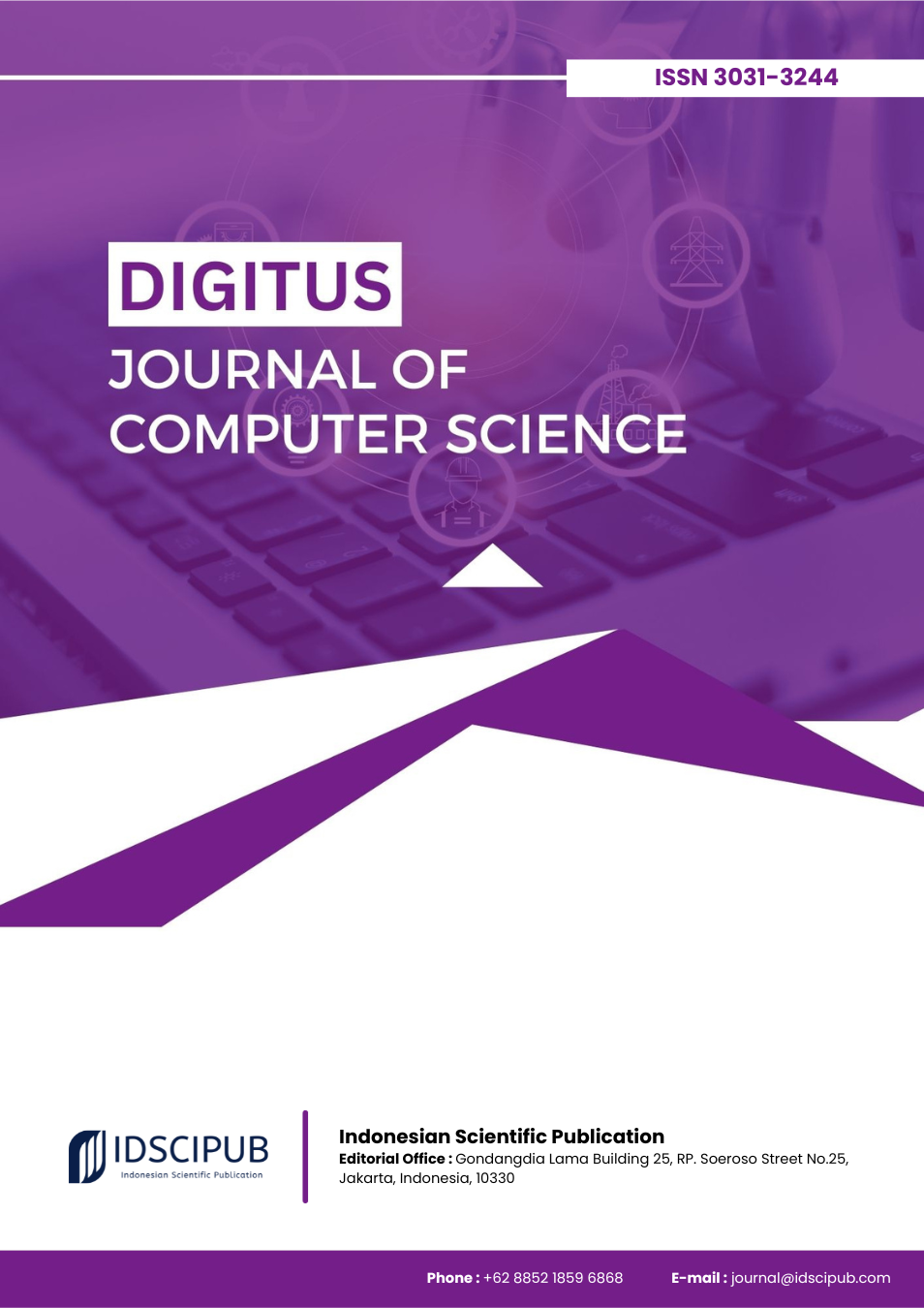Privacy-Preserving Machine Learning: Technological, Social, and Policy Perspectives
DOI:
https://doi.org/10.61978/digitus.v3i3.882Keywords:
Network Intrusion Detection, Deep Learning, Cybersecurity, Artificial Intelligence, Anomaly Detection, IoT Security, Explainable AIAbstract
As machine learning and data mining applications increasingly permeate sensitive domains, concerns over data privacy have intensified. This narrative review aims to synthesize current knowledge on privacy-preserving techniques in artificial intelligence, exploring the technological, socio-cultural, and economic-policy dimensions that shape their implementation. The review employed literature from databases including Scopus, IEEE Xplore, and PubMed, using keywords such as "privacy-preserving," "machine learning," and "differential privacy" to select peer-reviewed articles based on defined inclusion and exclusion criteria. The results reveal that differential privacy and federated learning are leading frameworks offering robust solutions for secure computation without compromising analytical performance. Deep learning models demonstrated strong accuracy, particularly when applied to complex datasets such as healthcare records. However, effectiveness is often impeded by systemic issues, including fragmented regulations and uneven infrastructural capacity. Moreover, socio-cultural factors like digital mistrust and limited awareness among users—especially older populations—pose additional barriers. Economic constraints and inconsistent international policy enforcement further complicate adoption across sectors. This review concludes that successful implementation of privacy-preserving technologies depends not only on algorithmic innovation but also on supportive regulatory, cultural, and financial ecosystems. It calls for integrated policy frameworks, targeted public education, and international cooperation to address existing barriers and advance the responsible use of AI in privacy-sensitive applications.
References
AboulEla, S., Ibrahim, N., Shehmir, S., Yadav, A., & Kashef, R. (2024). Navigating the cyber threat landscape: an in-depth analysis of attack detection within iot ecosystems. AI, 5(2), 704–732. https://doi.org/10.3390/ai5020037 DOI: https://doi.org/10.3390/ai5020037
Alabbadi, A. and Bajaber, F. (2025). An intrusion detection system over the iot data streams using explainable artificial intelligence (xai). Sensors, 25(3), 847. https://doi.org/10.3390/s25030847
Alayres, F., et al. (2023). Optimal fuzzy logic enabled intrusion detection for secure iot-cloud environment. Computers Materials & Continua, 74(3), 6737–6753. https://doi.org/10.32604/cmc.2023.032591
Alabbadi, A. and Bajaber, F. (2025). An intrusion detection system over the iot data streams using explainable artificial intelligence (xai). Sensors, 25(3), 847. https://doi.org/10.3390/s25030847 DOI: https://doi.org/10.3390/s25030847
Aldaej, A., Ahanger, T., & Ullah, I. (2023). Deep learning-inspired iot-ids mechanism for edge computing environments. Sensors, 23(24), 9869. https://doi.org/10.3390/s23249869 DOI: https://doi.org/10.3390/s23249869
Alrayes, F., Alshuqayran, N., Nour, M., Duhayyim, M., Mohamed, A., Mohammed, A., … & Yaseen, I. (2023). Optimal fuzzy logic enabled intrusion detection for secure iot-cloud environment. Computers Materials & Continua, 74(3), 6737–6753. https://doi.org/10.32604/cmc.2023.032591 DOI: https://doi.org/10.32604/cmc.2023.032591
Alsirhani, A., Tariq, N., Humayun, M., Alwakid, G., & Sanaullah, H. (2025). Intrusion detection in smart grids using artificial intelligence-based ensemble modelling. Cluster Computing, 28(4). https://doi.org/10.1007/s10586-024-04964-9 DOI: https://doi.org/10.1007/s10586-024-04964-9
Alsulami, M. (2024). An ai-driven model to enhance sustainability for the detection of cyber threats in iot environments. Sensors, 24(22), 7179. https://doi.org/10.3390/s24227179 DOI: https://doi.org/10.3390/s24227179
Arreche, O. and Abdallah, M. (2025). A comparative analysis of dnn-based white-box explainable ai methods in network security. EURASIP Journal on Information Security, 2025(1). https://doi.org/10.1186/s13635-025-00201-x DOI: https://doi.org/10.1186/s13635-025-00201-x
Choudhury, M. and Azad, C. (2022). Deep learning-based ai modeling, intrusion detection. In Handbook of Research on Cybersecurity Risk in Contemporary Business Systems (pp. 128–143). https://doi.org/10.4018/978-1-6684-4558-7.ch005 DOI: https://doi.org/10.4018/978-1-6684-4558-7.ch005
Dapel, M., Asante, M., Uba, C., & Agyeman, M. (2023). Artificial intelligence techniques in cybersecurity management. In AI and Cybersecurity (pp. 241–255). https://doi.org/10.1007/978-3-031-20160-8_14 DOI: https://doi.org/10.1007/978-3-031-20160-8_14
Deshmukh, A. and Ravulakollu, K. (2024). An efficient cnn-based intrusion detection system for iot: use case towards cybersecurity. Technologies, 12(10), 203. https://doi.org/10.3390/technologies12100203 DOI: https://doi.org/10.3390/technologies12100203
Habeeb, M. and Babu, T. (2022). Network intrusion detection system: a survey on artificial intelligence‐based techniques. Expert Systems, 39(9). https://doi.org/10.1111/exsy.13066 DOI: https://doi.org/10.1111/exsy.13066
Holubenko, V., Silva, P., & Bento, C. (2023). An intelligent mechanism for monitoring and detecting intrusions in iot devices. 2023 IEEE CCNC, 959–960. https://doi.org/10.1109/ccnc51644.2023.10060443 DOI: https://doi.org/10.1109/CCNC51644.2023.10060443
Houda, Z., Brik, B., & Khoukhi, L. (2022). “Why should I trust your IDS?”: an explainable deep learning framework for intrusion detection systems in IoT networks. IEEE Open Journal of the Communications Society, 3, 1164–1176. https://doi.org/10.1109/ojcoms.2022.3188750 DOI: https://doi.org/10.1109/OJCOMS.2022.3188750
Hussain, F., Abbas, S., Husnain, M., Fayyaz, U., Shahzad, F., & Shah, G. (2020). IoT DoS and DDoS attack detection using ResNet. 2020 INMIC. https://doi.org/10.1109/inmic50486.2020.9318216 DOI: https://doi.org/10.1109/INMIC50486.2020.9318216
Kazmi, S., Hassan, R., Qamar, F., Nisar, K., & Ibrahim, A. (2023). Security concepts in emerging 6G communication: threats, countermeasures, authentication techniques and research directions. Symmetry, 15(6), 1147. https://doi.org/10.3390/sym15061147 DOI: https://doi.org/10.3390/sym15061147
Krishnaveni, S., Jothi, B., Chen, T., & Sathiyanarayanan, M. (2024). TwinSec‐IDS: an enhanced intrusion detection system in SDN‐digital‐twin‐based industrial cyber‐physical systems. Concurrency and Computation Practice and Experience, 37(3). https://doi.org/10.1002/cpe.8334 DOI: https://doi.org/10.1002/cpe.8334
Mallampati, S. and Seetha, H. (2024). Enhancing intrusion detection with explainable ai: a transparent approach to network security. Cybernetics and Information Technologies, 24(1), 98–117. https://doi.org/10.2478/cait-2024-0006 DOI: https://doi.org/10.2478/cait-2024-0006
Mahbooba, B., Sahal, R., Alosaimi, W., & Serrano, M. (2021). Trust in intrusion detection systems: an investigation of performance analysis for machine learning and deep learning models. Complexity, 2021(1). https://doi.org/10.1155/2021/5538896 DOI: https://doi.org/10.1155/2021/5538896
Mambwe, H., Chavula, P., Kayusi, F., Lungu, G., & Uwimbabazi, A. (2024). Machine learning and AI for security mechanisms: a systematic literature review using a PRISMA framework. LatIA, 2, 331. https://doi.org/10.62486/latia2025331 DOI: https://doi.org/10.62486/latia2025331
Mansour, R. (2022). Artificial intelligence based optimization with deep learning model for blockchain enabled intrusion detection in cps environment. Scientific Reports, 12(1). https://doi.org/10.1038/s41598-022-17043-z DOI: https://doi.org/10.1038/s41598-022-17043-z
Mounir, M., Sayed, S., & Eldakroury, M. (2025). Securing the future: real-time intrusion detection in IIoT smart grids through innovative AI solutions. JCIM, 15(2), 208–244. https://doi.org/10.54216/jcim.150216 DOI: https://doi.org/10.54216/JCIM.150216
Moura, R., Franqueira, V., & Pessin, G. (2023). Cybersecurity in industrial networks: artificial intelligence techniques applied to intrusion detection systems. CSCE, 2235–2242. https://doi.org/10.1109/csce60160.2023.00365 DOI: https://doi.org/10.1109/CSCE60160.2023.00365
Neupane, S., et al. (2022). Explainable intrusion detection systems (X-IDS): a survey of current methods, challenges, and opportunities. IEEE Access, 10, 112392–112415. https://doi.org/10.1109/access.2022.3216617 DOI: https://doi.org/10.1109/ACCESS.2022.3216617
Otoum, S., Kantarcı, B., & Mouftah, H. (2021). A comparative study of AI-based intrusion detection techniques in critical infrastructures. ACM Transactions on Internet Technology, 21(4), 1–22. https://doi.org/10.1145/3406093 DOI: https://doi.org/10.1145/3406093
Popli, R., Sethi, M., Kansal, I., Garg, A., & Goyal, N. (2021). Machine learning based security solutions in MANETs: state of the art approaches. Journal of Physics: Conference Series, 1950(1), 012070. https://doi.org/10.1088/1742-6596/1950/1/012070 DOI: https://doi.org/10.1088/1742-6596/1950/1/012070
Qi, J. and Wang, J. (2024). Bridging artificial intelligence and railway cybersecurity: a comprehensive anomaly detection review. Transportation Research Record. https://doi.org/10.1177/03611981241302335 DOI: https://doi.org/10.1177/03611981241302335
Rahman, M., Dhakal, K., Gony, N., SD, M., & Rahman, M. (2025). AI integration in cybersecurity software: threat detection and response. IJIRSS, 8(3), 3907–3921. https://doi.org/10.53894/ijirss.v8i3.7403 DOI: https://doi.org/10.53894/ijirss.v8i3.7403
Rajapaksha, S., Kalutarage, H., Al-Kadri, M., Petrovski, A., Madzudzo, G., & Cheah, M. (2023). AI-based intrusion detection systems for in-vehicle networks: a survey. ACM Computing Surveys, 55(11), 1–40. https://doi.org/10.1145/3570954 DOI: https://doi.org/10.1145/3570954
Sabeel, U., Heydari, S., Elgazzar, K., & El‐Khatib, K. (2021). Building an intrusion detection system to detect atypical cyberattack flows. IEEE Access, 9, 94352–94370. https://doi.org/10.1109/access.2021.3093830 DOI: https://doi.org/10.1109/ACCESS.2021.3093830
Salem, A., Azzam, S., Emam, O., & Abohany, A. (2024). Advancing cybersecurity: a comprehensive review of AI-driven detection techniques. Journal of Big Data, 11(1). https://doi.org/10.1186/s40537-024-00957-y DOI: https://doi.org/10.1186/s40537-024-00957-y
Sayegh, H., Wang, D., & Al-madani, A. (2024). Enhanced intrusion detection with LSTM-based model, feature selection, and SMOTE for imbalanced data. Applied Sciences, 14(2), 479. https://doi.org/10.3390/app14020479 DOI: https://doi.org/10.3390/app14020479
Sharmila, B. and Nagapadma, R. (2023). Quantized autoencoder (QAE) intrusion detection system for anomaly detection in resource-constrained IoT devices using RT-IoT2022 dataset. Cybersecurity, 6(1). https://doi.org/10.1186/s42400-023-00178-5 DOI: https://doi.org/10.1186/s42400-023-00178-5
Shtayat, M., Hasan, M., Sulaiman, R., Islam, S., & Khan, A. (2023). An explainable ensemble deep learning approach for intrusion detection in industrial internet of things. IEEE Access, 11, 115047–115061. https://doi.org/10.1109/access.2023.3323573 DOI: https://doi.org/10.1109/ACCESS.2023.3323573
Soliman, K., Sobh, M., & Bahaa-Eldin, A. (2021). Survey of machine learning HIDS techniques. IEEE ICCES, 1–5. https://doi.org/10.1109/icces54031.2021.9686138 DOI: https://doi.org/10.1109/ICCES54031.2021.9686138
Souza, L., Sammarco, M., Achir, N., Campista, M., & Costa, L. (2024). AutomHS-GPT: automated model and hyperparameter selection with generative pre-trained model. IEEE CloudNet, 1–8. https://doi.org/10.1109/cloudnet62863.2024.10815898 DOI: https://doi.org/10.1109/CloudNet62863.2024.10815898
Thapa, N., Liu, Z., KC, D., Gokaraju, B., & Roy, K. (2020). Comparison of machine learning and deep learning models for network intrusion detection systems. Future Internet, 12(10), 167. https://doi.org/10.3390/fi12100167 DOI: https://doi.org/10.3390/fi12100167
Torre, D., Chennamaneni, A., Jo, J., Vyas, G., & Sabrsula, B. (2025). Toward enhancing privacy preservation of a federated learning CNN intrusion detection system in IoT. ACM TOSEM, 34(2), 1–48. https://doi.org/10.1145/3695998 DOI: https://doi.org/10.1145/3695998
Vinayakumar, R., KP, S., & Poornachandran, P. (2019). A comparative analysis of deep learning approaches for network intrusion detection systems (N-IDSs). IJDCF, 11(3), 65–89. https://doi.org/10.4018/ijdcf.2019070104 DOI: https://doi.org/10.4018/IJDCF.2019070104
Yang, L., Naser, S., Shami, A., Muhaidat, S., Ong, L., & Debbah, M. (2025). Towards zero touch networks: cross-layer automated security solutions for 6G wireless networks. IEEE Transactions on Communications, 1–1. https://doi.org/10.1109/tcomm.2025.3547764 DOI: https://doi.org/10.1109/TCOMM.2025.3547764
Zhou, X., Liang, W., Shimizu, S., Ma, J., & Jin, Q. (2021). Siamese neural network based few-shot learning for anomaly detection in industrial cyber-physical systems. IEEE Transactions on Industrial Informatics, 17(8), 5790–5798. https://doi.org/10.1109/tii.2020.3047675 DOI: https://doi.org/10.1109/TII.2020.3047675
Zubair, M., et al. (2022). Secure bluetooth communication in smart healthcare systems: a novel community dataset and intrusion detection system. Sensors, 22(21), 8280. https://doi.org/10.3390/s22218280 DOI: https://doi.org/10.3390/s22218280





